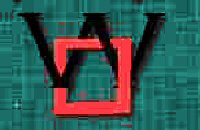 Analyses of all verses
Analyses of all verses
|
 Web Site
Web Site |
 All
Sefirots All
Sefirots |
|
BOOKMARKS American Disaster in Iran in 21st Century.
N's Referencing of Alexander's campaign
Other quatrains holding anagrams for American.
Neurologic Illness Evidence in 'American' Quatrains.
Oil
and chemicals motivate the war.
The quatrain that unites the themes.
|
|

Carmanie is the name by which the Persian Empire was known at the time of Alexander's campaign. Iran is the name we use today for the land and coast where the actions in the above verse take place.
The third line of the above quatrain has anagrams for 'ameriCan diSaSterS' held in SSe iStra de Carmani and the use of capital letters imply these are meant to be powerful coding markers. That they occur as adjacent infrequent anagrams also highlights their importance.
To these strong attributes are added their appropriateness to the story in Nostradamus' text and the parallelism of Alexander's campaigns.
Much of Nostradamus' coding involves the use of allegories that use past events as a frame on which present and future tales are based. In the four verses where there is an anagram of American these allegories are used to set the story of an American fleet based in the Persian Gulf in support of a US marine Commander. The naval role is part of a ca
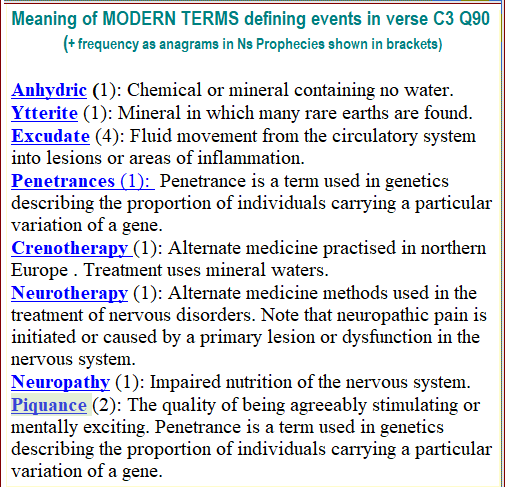 mpaign against Iran and the other Arab nations of the Persian Gulf
and Mediterranean Sea.
mpaign against Iran and the other Arab nations of the Persian Gulf
and Mediterranean Sea. From the anagrams it is apparent that the disaster involves diseases arising from the landscape of southern Iran.
This match of a story from a time that is four centuries before Christ implies any significance lies in its allusive relationship to the modern story. This story is given next since it seems important to seeing the strength of these connections.
The historical referencing of Alexander's campaign in Iran
This verse’s text highlights Nostradamus’
style of mixing past with present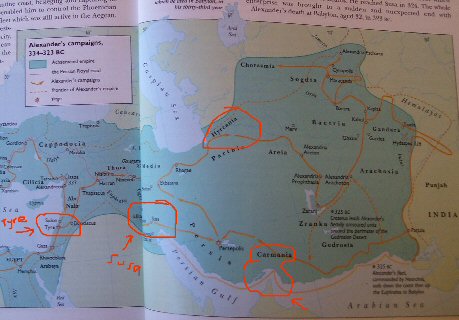 to indicate the future. It is through the
details of Alexander’s campaign that he indicates the places and routes used
by the
United States
in what is most likely a war with
Iran.
The map alongside covers the area from the Mediterranean Sea
across the modern
lands of Syria, Iraq, Iran,
to indicate the future. It is through the
details of Alexander’s campaign that he indicates the places and routes used
by the
United States
in what is most likely a war with
Iran.
The map alongside covers the area from the Mediterranean Sea
across the modern
lands of Syria, Iraq, Iran,
Afghanistan
to Pakistan.
The ancient fleet’s chief mentioned in the third
line is Nearchus, Alexander's naval commander.
On one occasion the two men were reunited in Carmania after they had undertaken separate sea and land routes from the Indus River. From here, in 325 BCE, they once again went separate ways with the army, led by Alexander, travelling towards Susa via the coastal passes while Nearchus journeyed along the Persian/Arabian Gulf towards the same destination (L.3 ). On an earlier venture they had taken the city of Tyre in Phoenicia by building a causeway to link the mainland with the island on which Tyre was then located (L.4 ). And in between these events they had journeyed together through the heart of Carmania ( Iran ) to Tehran in the region then called Hyrcania.
P120 -The Penguin Historical Atlas of Ancient Greece: Robert Morkot, 1996
The other three verses containing the anagram of American.
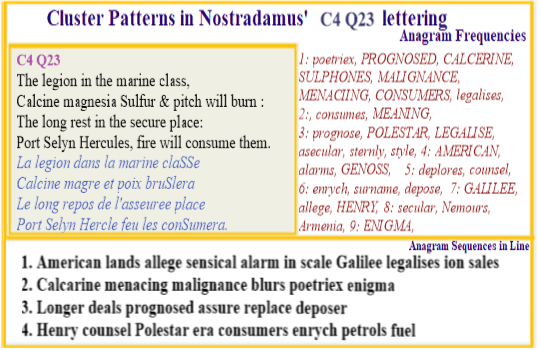 The
first of these other verses) C04 Q23) is about a
disaster involving
American /
Carmanie (dans l - a marine
c) lands.
Carmanie refers to territory in Iran that borders the Gulf of Hormuz.
The
first of these other verses) C04 Q23) is about a
disaster involving
American /
Carmanie (dans l - a marine
c) lands.
Carmanie refers to territory in Iran that borders the Gulf of Hormuz.The anagrams of this verse identify the place where the action occurs as a fuel seaport (era PortS), thereby helping to confirm the location is in the Persian Gulf and there are also anagrams for fuel consumes era petrols enrich (feu l -es conSum - era - Port Sel - yn Herc).
But this information is also mixed with some coding clues that point to the name of the person who is the protagonist. His first name is Henry and his surname is to be found interwoven into the four lines.
The next of the four verses cites an American incident that is clearly about unwise worldwide expansionism.
This verse is one of four that has an anagram for American in its text. In this page, American Disaster in Iran, I show the consistency in these four verses. In total they produce a story that uses Alexander the Great's campaigns in Persia as a mirror image of what will happen in the twenty-first century.
In this verse we see some of the elements that are repeated in the complete set and these relate to a disaster in the Gulf of Hormuz involving minerals released into the sea. It is part of an anti-imperial campaign that traverses the Alexandrian routes from the Gulf to the city of Susa by land and sea. This has always been difficult terrain for any army and it remains the case today. The Ishmaelites mentioned in the text most likely refers to a branch of Shia Islam whose adherents are also known as Seveners.
So far I have used only the lines containing an anagram of the word American and shown that the lettering holds patterning that is outside what we might expect by chance alone. This is also true of the consistency in the line and its anagrams and the meaning within the verse and across the three verses. There is no distortion of the lettering (except UV for W) and in the last two there is a completeness and regularity of order. All this implies that this exploration is worth continuing.
The fourth of the four verses C9 Q48 contains similar strengths that relate to the timing and more about the location. At the same time we see the same type of chemical events and themes raised in the other verses.
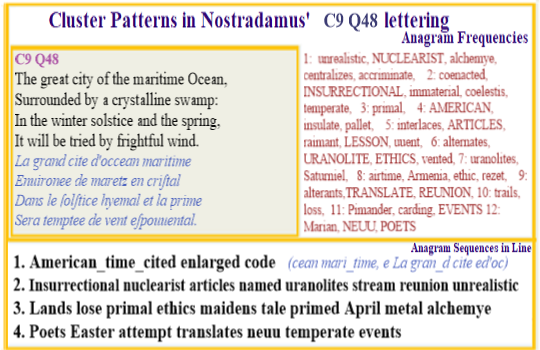 This verse's theme is linked closely to that of the preceding one (see
C9 Q47). Both have anagrams that involve nuclear
terminology and both sit within the theme set out in this paper on
American
Disaster in Iran. The verse has a set of adjacent
anagrams that indicates the timing of this disaster is held within the hidden
content since they say '
American time code'.
This verse's theme is linked closely to that of the preceding one (see
C9 Q47). Both have anagrams that involve nuclear
terminology and both sit within the theme set out in this paper on
American
Disaster in Iran. The verse has a set of adjacent
anagrams that indicates the timing of this disaster is held within the hidden
content since they say '
American time code'.
The text reinforces this idea in its third line telling us of the solar event and the season when the tragedy takes place. But in that same line there are anagrams identifying 'late April' as the specific time when a frightful wind will strike. Other anagrams tell us that the initial events involve insurrection at a place where nuclear materials are blended. This unrest allows America to brand Iran as a criminal state and to invade in order to eliminate the sources of production.
The first line has two intriguing sequences since they deal with the same theme as raised in the third line which sets out the timing of the events in the verse. The first line, which holds the anagram for American has a sequence that says It garland American time code (La grand -ti - e d'oc- cean mari - time).
This provides the clue that the line with time references adorns a more precise date for the American events. Now the third line holds In the winter solstice and the spring, and hidden in the same line can be seen anagrams that say late April named (al et - la pri - me Dan). This is a powerful cross referencing device which is once again difficult to explain as a product of chance alone. The extent of this complexity goes much further.